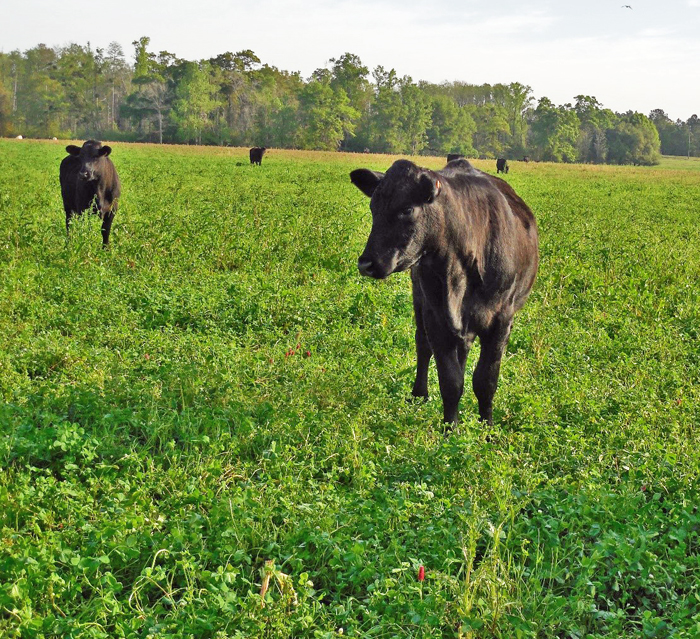
Cattle grazing a mixed cool-season forage pasture that includes cereal rye and crimson clover. Photo credit: Cheryl Mackowiak
Prepare your land for winter grazing by closely grazing or mowing down the existing pasture in the fall, prior to planting. This results in less water, nutrient, and light competition with the emerging cool-season forages. You can also till an area for producing cool-season forages. Forages started in tilled soil will grow faster and often outperform overseeded forages. A prepared seedbed minimizes competition for resources and during cooler periods, the exposed soil will warm more than soil under residues.
Target soil pH to a range from 5.5 to 6.5. If you find that your soil is near the low (acidic) end of the scale, consider applying lime. However, do not apply lime within a month of your fertilizer application, as you may increase nitrogen volatilization (N loss) and tie-up more soil phosphorous (P), leading to less available fertilizer for the plants. If you have not limed yet, you might consider waiting until winter, or before the spring transition into summer forages.
Cool-season grazing may include a combination of grasses (small grains, annual ryegrass), legumes (clovers, vetch, winter pea), and even brassicas (turnips). The legumes and brassicas tend to take up more potassium, calcium, magnesium, sulfur, and micronutrients than grasses so make sure your pasture is adequately fertilized to support these forages. The only way to determine this is by sampling the soil and having it analyzed by a reputable lab. The soil report will provide liming and fertilizer recommendations for the forage you specify. In mixed plantings, you might request your recommendations be based upon the legume component, as the nitrogen (N) recommendation for grasses is not based upon the soil analysis, and legumes fix N. If you apply fertilizer to meet the legume needs, you will have ample fertilizer (except N) available for the grass component.
For cool-season grasses in Florida, 30 lbs N/acre is recommended at or near planting, then another 40 to 50 lbs N/ac after the plants have established (beginning to branch or tiller). If you want greater clover competition, apply less N (30 to 50 lbs near planting and no additional application). Under grazing, you might find that applying another 30 to 50 lbs N/acre in early spring is required, particularly if there are leaching rains, or livestock are not redistributing excrement uniformly across the pasture. If El Nino conditions prevail through the 2016 winter/spring, you may find yourself under flooded conditions. Annual ryegrass and white clover survive saturated soils better than most other Florida cool-season forage options. Saturated soils will also lose N via denitrification (gaseous loss). Do not apply additional N fertilizer until the soils have adequately drained.
Planting now through mid-November will ensure well-established plants with deep root systems to help capture nutrients that might leach during large rain events. Also, managing your grazing to retain adequate forage (3 inches or more stubble height or grazing to remove only half of your canopy height) will insure adequate rooting mass and depth, in order to capture soil nutrients deeper in the soil profile and promote stronger, more resilient plants and faster regrowth.
Keep in mind that the fertilizer investment you make for your cool-season forages will be returned to you in animal gains and a healthier pasture. The root mass from winter forages will decompose in early summer, contributing organic matter and slow-release nutrients to the soil that will help support the summer pasture.
The UF/IFAS fertilization recommendations can be found online at:
UF/IFAS Standardized Fertilization Recommendations for Agronomic Crops
- Grower Survey Insights on Cotton Nitrogen Management in Florida’s Panhandle - July 18, 2025
- Florida Soils are an Indispensable Natural Resource - January 10, 2025
- Regenerative Agriculture: What it Means to You - June 21, 2024
